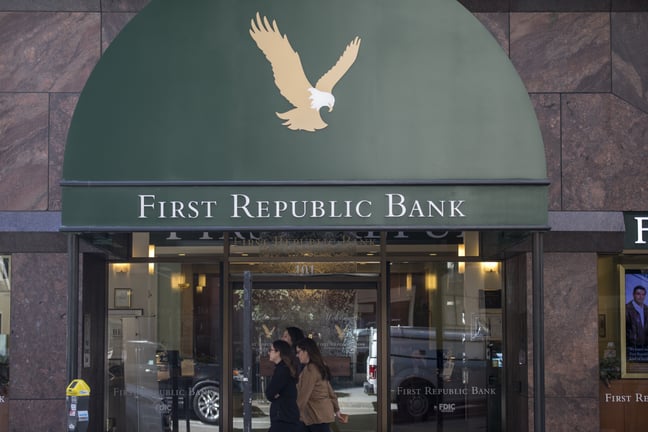Competition Killed Your Local Bank

Another day and another bank failure. Silicon Valley Bank, Signature Bank, and now First Republic Bank. More than half of the banks in the US have negative tangible equity by some accounts. That’s a fancy way of saying that over half of America’s banks are insolvent and are teetering on collapse. Scary stuff.
Economists are pointing to the rise in interest rates diluting the value of assets on the bank’s books, congress is blaming bad regulatory oversite and bank regulators are blaming bad bank management. However, there could be a simple fourth reason banks have failed and that’s brutal competition.
So far, the banks that have failed focused on a pretty specific bank model: These banks catered to the uber wealthy multi-million dollar depositors. When these depositors saw balance sheets at their banks weaken, they got spooked and moved their money causing a run on the bank. That’s only half the story.
Catering to the wealthy who have millions is not like servicing Mr and Mrs Public. The wealthy can be very demanding. Private banking the rich has made virtual slaves out of bank officers. A multi-million dollar depositor says “jump”, bank officers often say “how high?” They surely don’t want to see those millions in deposits leave the bank to a competitor.

How high do they jump? Well, when the wealthy want a real estate loan, they expect the lowest of rates. When they need a car lease, they want it cheap; most times well below market rates that your average middle class borrower can get. During the past years of low rate frenzy, the rates on real estate loans hovered around 3%, so the wealthy expected 2%. The rich are different than everyone else. To the bank, it seemed like a fair request.
“You have millions in my bank which I am paying you nothing to maybe half a percent and you are asking me to loan you your own money at 2%.” There was a profit there. The problem with that model was real estate loans are fixed for 5, 10, 20 even 30 years while the deposits are on demand. When things hit the fan, demand they did.
The bank got squeezed when rates went up and those real estate loans the wealthy were given were worth less than face value. Not a problem if depositors kept their money in the bank. If the depositors want their money back though, now the bank has a problem. How does a bank pay back cash when the money is tied up in fixed asset loans? It can’t. It either has to sell assets at a loss or borrow from the federal reserve at rates higher than the assets are earning. Both scenarios are not good. If enough depositors demand their money, it’s a run on the bank, and well, you know the rest.
So, what does this have to do with competition? Everything. Banks aren’t the only lenders today. For the past couple of decades, banks have been under assault by thousands of unregulated private and public institutions with cheap money to lend. That has pushed regulated institutions to battle for business. Heavy competition in any business will cause margins to erode, and banking is no different.

If your margins are shrinking, you try and make it up with volume. It’s really the only way to grow profits in a competitive environment. For a bank that means attracting deposits. The downside of deposits are they are a liability on the balance sheet and an expense on the P&L. The more deposits you attract, the more loans and investments you must find. Competition made finding good loans with good margin harder and harder to attract. Small loans pose a problem as well. It takes a lot of $50,000 auto loans to put out a billion dollars.
Some community banks found it was easier to manage one ten million-dollar loan than thousands of small retail loans and attracting a million dollar depositor with over the top service was easier than $2500 savings accounts.
Community banks used to be your neighborhood lender, loaning to the coffee shop on Main Street and that machine shop on Industrial Boulevard. Drop in for a cup of coffee and a donut in the lobby. Small community banks for years were getting crushed in rate competition. When your local banker quotes a rate of 5% and a national online lender advertises 3.5%, which do you choose? Then there is pressure from stockholders, who are no longer satisfied with dividends and donuts; they want to see the stock move. Competition has forced your local bank to bulk up or die.
That’s how small banks like Silicon Valley Bank, Signature and First Republic Bank grew to compete with the big boys. These banks didn’t have the infrastructure to attract and manage small loans and deposits like national banks, nor were they able to securitize loans to minimize risk, so they swung for the fences attracting muti-million dollar deposits and loans to grow. That left them vulnerable to rate increases and fickle uber-wealthy depositors who left them with below-market loans and no deposits to offset them.
How many more SVB, First Republic or Signatures are there out there? More than we would like to know. Let's just hope Mr. and Mrs. John Q. Depositor don't look too closely at their bank's balance sheet and cause a panic your neighborhood.

If you are looking for a fair deal for your family business, take a minute and give AeroFund Financial a call.
-Steve Troy
CEO AeroFund Holdings, Inc.
